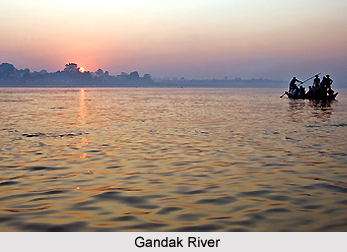 Geography of Siwan District is spanned over the western part of North Bihar alluvial plain`s segment of broader Indo-Gangetic Plain. Structurally, the district forms a part of the alluvium of the broader Indo-Gangetic Plain. The geological formation of the tract is of recent (Holocene) period. The contribution of the Himalayan Rivers to the formation of the tract is significant. It is estimated that the district covers the deposits of alluvium more than 5000 feet in depth. Geo-morphologically, it forms the part of Gandak, which is the outcome of the discharge and silt-charge of the Himalayan Rivers to the plain during the phase of deposition. The whole district bears a featureless terrain having general slope from northwest to southeast. However, the slope is almost invisible.
Geography of Siwan District is spanned over the western part of North Bihar alluvial plain`s segment of broader Indo-Gangetic Plain. Structurally, the district forms a part of the alluvium of the broader Indo-Gangetic Plain. The geological formation of the tract is of recent (Holocene) period. The contribution of the Himalayan Rivers to the formation of the tract is significant. It is estimated that the district covers the deposits of alluvium more than 5000 feet in depth. Geo-morphologically, it forms the part of Gandak, which is the outcome of the discharge and silt-charge of the Himalayan Rivers to the plain during the phase of deposition. The whole district bears a featureless terrain having general slope from northwest to southeast. However, the slope is almost invisible.
Rivers of Siwan District
Further, the district is drained by few small rivers like Jharahi River, Daha River, Gandaki River, Dhamati River (Dhamahi River), Siahi River, Nikari River and Sona River. The southern boundary of the district is formed by Ghaghara River, the main stream of the area. Among these, Ghaghara is the only perennial river because of its Himalayan source and rest of the rivers bears different origins. The rivers of the district get inundated almost every year. The area is characterized by certain typical geographical features like `Chaurs`, some of which give birth to short length streams locally known as `Nadi` or `Sota`. Rivers Jharahi and Daha are the tributaries of river Ghaghara, while Gandak and Dhamati are of river Gandak. The Siahi and Nikari streams drain to Jharahi, While Sona drains to river Daha. These streams play important role in carrying out excess water from the region during rainy season. Siwan, the district headquarters, is located on the eastern bank of river Daha.
The southern part of Siwan District along river Ghaghara is marked by `Draras`, which are typical formation of the sand heaping with thin layer of clay and silt over them.
Climate of Siwan District
The district gets its place in the transitional zone of drier climatic condition of Uttar Pradesh and moist climatic condition of West Bengal, but as it is closer to Uttar Pradesh geography of Siwan District is characterized with drier climatic condition. The area observes hot westerly winds, which start in March and last until May, but in April and May light, damp easterly winds blow intermittently and afternoon storms accompanied with rain occurs. The summer season experiences a temperature rise up to 38 degree Celsius. Since the district is in transitional zone monsoon rain starts late here and persists till September. This period provides maximum rain to the area. July and August are the oppressive months due to heat intermixed with high humidity. The winter season is normally pleasant with low temperature. The average annual rainfall of the district is 120 cm.






